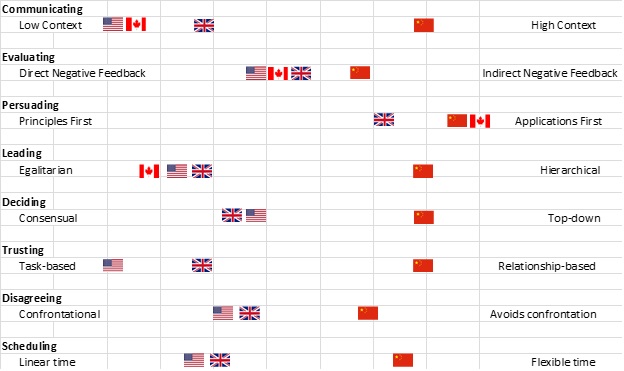Thanks for your comments to my previous message re: “social distancing.” Accordingly, I have updated my blog post, “Phygital Distancing, not Social Distancing.” In that post, I asserted that “social distance” is the degree of acceptance or rejection of social interaction between people belonging to different social groups such as ethnicity, language and culture. I also promised to address social distance in the context of cultural diversity and fluency.
Culture researchers (Hall, Hofstede, Livermore, Meyer, Plueddemann, Trompenaars, et al.) have identified various facets which characterize cultural diversity. Typically, each of these lies on a continuum. For example:
- Communicating: high context vs. low context
- Evaluating: direct or indirect
- Leading: hierarchical vs. egalitarian
Refer to Erin Meyer’s articles, “Navigating the Cultural Minefield” and “Being the Boss in Brussels, Boston, and Beijing,” in the Harvard Business Review. In the Culture Map, Meyer summarizes eight facets by country. For example:

In particular, in their communication, Canada, the US and the UK are on the low context end of the continuum whereas the PRC is on the other end. This is exemplified by the need for explicitness in the West by asking for clarification and verification, but implicitness in the East where it is necessary to read between the lines. Regarding giving feedback, the typical approach by people from the West is assertion whereas it has been construed as passive aggressive behaviour of those from the East.
The leading scale indicates the degree of respect and deference given to people in authority. This is akin to the concept of power distance advanced by Geert Hofstede. It is derived from research by social psychologist Mauk Mulder re: the emotional distance that separates subordinates from their superiors. Hofstede defines power distance as “the extent to which the less powerful members of institutions and organizations expect and accept that power is distributed unequally,” and clarifies that institutions are the basic elements of society (family, school, community) and organizations are where people work. David Livermore distills power distance as the amount of distance that is expected between leaders and followers. High power distance is characterized by authoritative, hierarchical, and top-down. Attributes of low power distance include democratic, egalitarian, and peer. In low power distance cultures, power is delegated; those at the lower-ranking levels of society (children, students, employees) have a say. At the other pole where both the leaders and followers accept that the leader has higher authority, the followers defer to the leaders with respect and without question. In particular, Canada, the US and the UK lean toward being egalitarian and the PRC being more hierarchical. Watch this short video, “How Cultures Across the World Approach Leadership.”
In their book, Flex: The New Playbook for Managing Across Differences, Jane Huyn and Audrey Lee define culture as the “unique combination of attitudes, knowledge, behaviours, and strategies of a social group that are reinforced by the community.” Also, they define power gap as the “social distance that separates individuals from those in positions of authority, whether in a formal or more informal structure, defined by gender, age, or cultural differences.” Therefore, within a social context, social distance could be misconstrued as power distance. Thus, social distancing could suggest widening the gap between people in our society with differences, be it age, gender, ethnicity, social status. For example, leaders are elevated to the pinnacle of their pedestals, and followers are relegated to the footstools. Alas, this notion of social separation is worse than the simplistic notion of extending the chronological distance (time, duration, frequency) between social interactions.
FWIW, the bottomline, IMHO, is that we need to stop promoting “social distancing” as it encourages the wrong behavioural response which could be harmful psychologically and physically. We need to mitigate the risk of social disconnect and social dissonance. We need to intentionally bridge the physical divide by purposefully strengthening our social network. Using hi-tech to supplement hi-touch can help us gain, retain and sustain social engagements with one another (Hebrews 10:24—25).